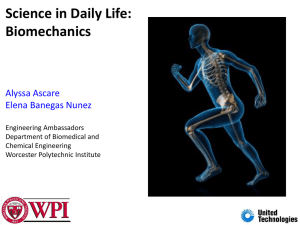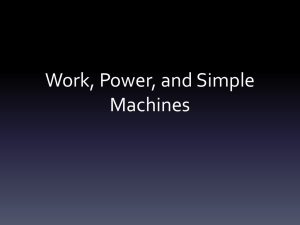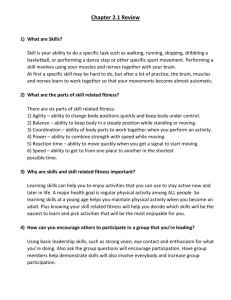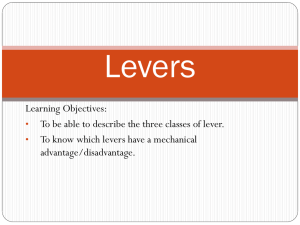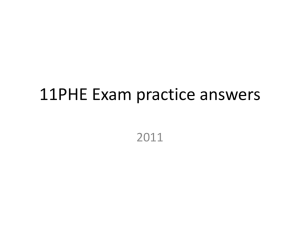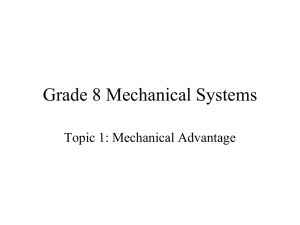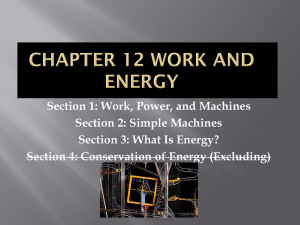Work, Power, and Machines
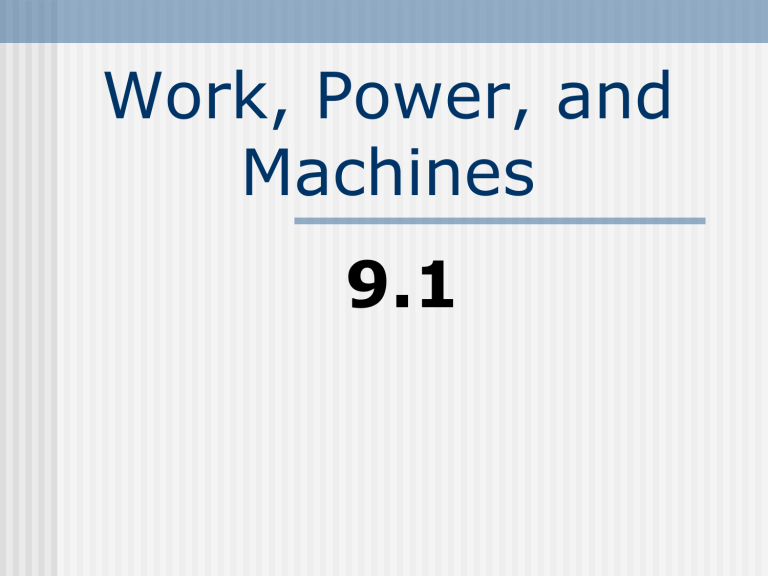
Work, Power, and
Machines
9.1
Work
A quantity that measures the effects of a force acting over a distance
Work = force x distance
W = Fd
Work
Work is measured in:
N m
Joules (J)
Work Example
A crane uses an average force of 5200
N to lift a girder 25 m.
How much work does the crane do?
Work Example
Work = Fd
Work = (5200 N)(25m)
Work = 130000 N m
= 130000 J
Power
A quantity that measures the rate at which work is done
Power = work/time
P = W/t
Power
Watts (W) is the SI unit for power
1 W = 1 J/s
Power Example
While rowing in a race,
John uses 19.8 N to travel 200.0 meters in
60.0 s. What is his power output in Watts?
Power Example
Work = Fd
Work = 19.8 N x 200.0 m= 3960 J
Power = W/t
Power = 3960 J/60.0 s
Power = 66.0 W
Machines
Help us do work by redistributing the force that we put into them
They do not change the amount of work
Machines
Change the direction of an input force (ex car jack)
Machines
Increase an output force by changing the distance over which the force is applied
(ex ramp)
Multiplying forces
Mechanical Advantage
A quantity that measures how much a machine multiples force or distance.
Mechanical Advantage
Mech. Adv =
Input distance
Output Distance
Mech. Adv. =
Output Force
Input Force
Mech. Adv. example
Calculate the mechanical advantage of a ramp that is 6.0 m long and 1.5 m high.
Mech. Adv. Example
Input = 6.0 m
Output = 1.5 m
Mech. Adv.=6.0m/1.5m
Mech. Adv. = 4.0
Simple Machines
9.2
Simple Machines
Most basic machines
Made up of two families
Levers
Inclined planes
The Lever Family
All levers have a rigid
arm that turns around a point called the
fulcrum.
The Lever Family
Levers are divided into three classes
Classes depend on the location of the fulcrum and the input/output forces.
First Class Levers
Have fulcrum in middle of arm.
The input/output forces act on opposite ends
Ex. Hammer, Pliers
First Class Levers
Output Force Input Force
Fulcrum
Second Class Levers
Fulcrum is at one end.
Input force is applied to the other end.
Ex. Wheel barrow, hinged doors, nutcracker
Second Class Levers
Output Force
Fulcrum
Input Force
Third Class Levers
Multiply distance rather than force.
Ex. Human forearm
Third Class Levers
The muscle contracts a short distance to move the hand a large distance
Third Class Levers
Output distance
Fulcrum
Input Force
Pulleys
Act like a modified member of the first-class lever family
Used to lift objects
Output
Force
Pulleys
Input force
The Inclined Plane
Incline planes multiply and redirect force by changing the distance
Ex loading ramp
The Inclined Plane
Turns a small input force into a large output force by spreading the work out over a large distance
A Wedge
Functions like two inclined planes back to back
A Wedge
Turns a single downward force into two forces directed out to the sides
Ex. An axe , nail
Or Wedge Antilles from Star Wars
Not to be mistaken with a wedgIEEEEE
A Screw
Inclined plane wrapped around a cylinder
A Screw
Tightening a screw requires less input force over a greater distance
Ex. Jar lids
Compound Machines
A machine that combines two or more simple machines
Ex. Scissors, bike gears, car jacks
Energy
9.3-9.4
Energy and Work
Energy is the ability to do work
whenever work is done, energy is transformed or transferred to another system.
Energy
Energy is measured in:
Joules (J)
Energy can only be observed when work is being done on an object
Potential Energy PE
the stored energy resulting from the relative positions of objects in a system
Potential Energy PE
PE of any stretched elastic material is called
Elastic PE
ex. a rubber band, bungee cord, clock spring
Gravitational PE
energy that could potentially do work on an object do to the forces of gravity.
Gravitational PE
depends both on the mass of the object and the distance between them
(height)
Gravitational PE
Equation grav. PE= mass x gravity x height
PE = mgh or
PE = wh
PE Example
A 65 kg rock climber ascends a cliff. What is the climber’s gravitational PE at a point 35 m above the base of the cliff?
PE Example
PE = mgh
PE=(65kg)(9.8m/s 2 )(35m)
PE = 2.2 x 10 4 J
PE = 22000 J
Kinetic Energy
the energy of a moving object due to its motion.
depends on an objects mass and speed.
Kinetic Energy
What influences energy more: speed or mass?
ex. Car crashes
Speed does
Kinetic Energy
Equation
KE=1/2 x mass x speed squared
KE = ½ mv 2
KE Example
What is the kinetic energy of a 44 kg cheetah running at
31 m/s?
KE Example
KE = ½ mv 2
KE= ½(44kg)(31m/s) 2
KE=2.1 x 10 4 J
KE = 21000 J
Mechanical Energy
the sum of the KE and the PE of large-scale objects in a system
work being done
Nonmechanical
Energy
Energy that lies at the level of atoms and does not affect motion on a large scale.
Atoms
Atoms have KE, because they at constantly in motion.
KE particles heat up
KE particles cool down
Chemical Reactions
during reactions stored energy (called chemical energy)is released
So PE is converted to
KE
Other Forms
nuclear fusion
nuclear fission
Electricity
Light
Energy
Transformations
9.4
Conservation of
Energy
Energy is neither created nor destroyed
Energy is transferred
Energy
Transformation
PE becomes KE
car going down a hill on a roller coaster
Energy
Transformation
KE can become PE
car going up a hill
KE starts converting to PE
Physics of roller coasters
http://www.funderstanding.com/k12/coa ster/
